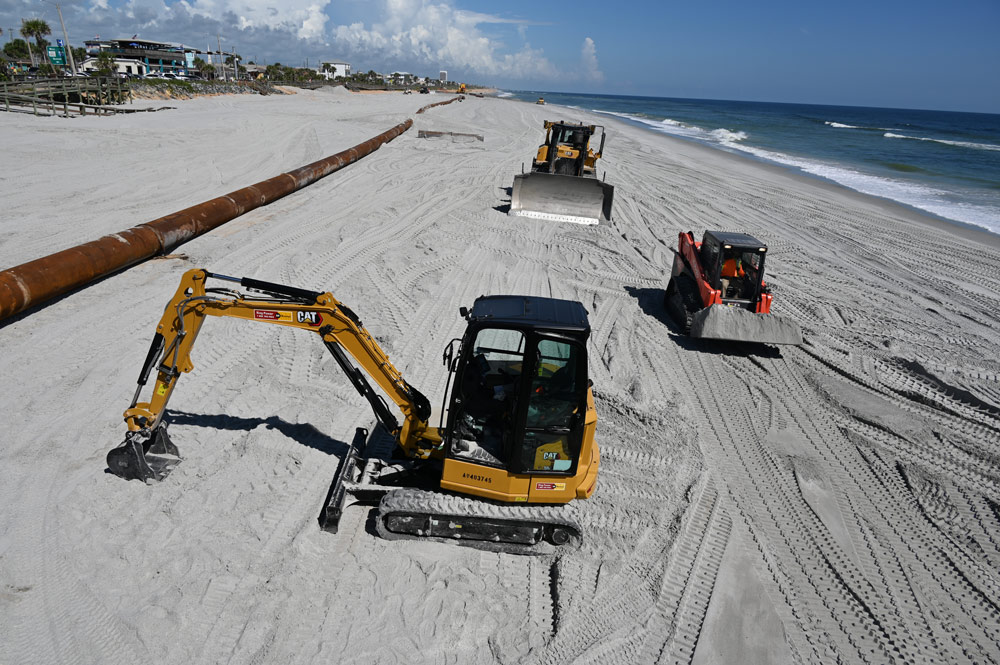
The good news, if you believe in prolonging the life of Flagler County’s shoreline for at least a few decades: The county is preparing to rebuild dunes and beaches along a 5.5-mile stretch from North 7th Street in Flagler Beach to Varn Park, just south of the Hammock.
Money for the $36 million project has been secured through state and federal grants. The county is close to securing the 1.8 million cubic yards of sand from a borrow area several miles offshore, adjacent to the one that fed the new sand to the 3.2-mile stretch of beach the U.S. Army Corps of Engineers rebuilt last summer, from North 6th Street to just south of South 28th Street in Flagler Beach.
The county attorney’s office is securing all the necessary easements along the 5 miles that will be rebuilt, clearing the way for the contractor to work on private property along the shore. The county hopes to have its contractor rebuilding the beach as soon as October, but more likely a few months into the new year.
The bad news: all of that will be just a temporary fix that will erode away in a few years, as will the 3.2 miles of the Army Corps project, if the county and its cities don’t agree on a beach-management plan to finance beach protection in the long term. The plan’s centerpiece is a half-penny increase in the sales tax, with much of that revenue going to beach protection. The plan would ensure that the Army Corps project and the soon-to-be rebuilt 5.5-mile segment have the necessary money to pay for the next renourishment, or reconstruction, due about six years or less from now.
By early March a consensus had built among Flagler County commissioners to endorse the plan, and cities were warming up to it. By early April, three commissioners were signaling opposition. The commission will make a decision on the plan at a May 5 workshop.
There was no objection or opposition to the 5.5-mile beach-renourishment plan the county administration presented today: commissioners were ready to approve it in whatever format, though the only things they’ll have to approve in coming weeks or months are formalities such as permits or the contract with the dredging company that will do the job.
Yet the disconnect among some commissioners was clear: they are supportive of extending beach and dune reconstruction efforts along miles of shore, most of those miles in Flagler Beach and Beverly Beach, and more to come further north. But a majority of them are reluctant to ensure that the renourishing is not wasted–as it will be if it is not followed by subsequent renourishments.
Today’s workshop did not resolve the contradiction. It wasn’t intended to. The aim today was focused on what’s immediately ahead, with the money and permits in hand, or almost in hand, and what should follow in the next two years. Implicit in today’s presentation was a message to residents and city governments: here’s what county government can do, if you entrust it with beach management.
The plan was presented by Ansley Wren-Key, the county’s coastal engineer and point person on the beach management plan.
It’s a story of “Reaches”: The coastal community in government refers to different segments of beach as “reaches.” There are four such reaches along Flagler County’s 18 miles of shore. Reach 1 was the segment rebuilt by the Army Corps. Reach 2 is on deck for reconstruction. Reach 3 extends from Varn Park to just south of Washington Oaks State Park. Reach 4 is the 2.7-mile stretch from Washington Oaks to the border with St. Johns County.
Each Reach has its own reconstruction plan. Only Reach 2 is fully funded, though the county is working toward getting Reach 3 funded and rebuilt in 2027.
The county’s beach-renourishment will not be quite as robust as that of the Army Corps. The sand volume will be somewhat less per square yard. But the county has requested a new feasibility study as a first step to extending the Army Corps’ beach-renourishment standard further north. But if the county is successful, and as with the existing Army Corps project, the county will be responsible for paying half of each renourishment ahead, every five years, at the Corps’ steeper prices–making a beach-management funding system that much more essential. (The county has not calculated whether it could afford future renourishments on the Corps’ standards along twice as much shoreline.)
Reach 2 includes an odd appendage at the southernmost end of the county. The commission will have to decide whether to include that in beach reconstruction or not. The short segment, from the county line north, to Gamble Rogers State Recreation Area, would add some $4 million to the $36 million project, and raise the length of the reach to 7 miles.
“I don’t see any benefit to our government, to our tourists, to anything by adding that little glitch in the current plan,” Commissioner Kim Carney said. By “glitch,” she was referring to the sands that would be concurrent with a new secant–or sea–wall the Department of Transportation is building there. The State Department of Transportation has agreed to spend $500,000 a year to maintain a sand cover over that wall and one line it south of Beverly Beach. But the county fears the amount is too little to cover both walls adequately. And it will provide no sand to rebuild the beach itself.
Secant walls tend to erode the beaches in front of them. Residents at the south end of the county are concerned about losing their beach with that new wall. The county would fill that gap, in essence rebuilding the beach that used to be there many years ago. Since the dunes are not part of the burden to the county, the county could do the job for about $4 million.
Permits will be in place June 30, Ansley said. The reconstruction could potentially start in October.
To Commissioner Pam Richardson, that’s smack in the middle of hurricane season. “One storm could just destroy everything we just put back there, right? Am I wrong?” she asked.
“Unfortunately, like you say, it will be in hurricane season at the time,” County Engineer Hamid Tabassian said, “but if everything goes as planned, and we have the bids in, say, August, these things don’t happen immediately, so it may be December, or even maybe January of ‘26 before the actual work starts. Once it does, it happens and gets finished rapidly.”
In any case, Ansley said the county may have more favorable terms with the dredging industry in March 2026 than at the end of this year, hence the possible delay to next year.
For Reach 4, the 2.7 miles at the north end of the county, the extensive coquina rock dotting the sands prevents the same kind of beach renourishment: the rocks are considered to be a protected environmental resource. So beach management there will be limited to dune reconstruction. The beach will have to fare for itself.
“There was not a rock issue prior to Matthew,” Commissioner Greg Hansen said, referring to Hurricane Matthew in 2016. “So Matthew uncovered them, and [County Administrator Heidi Petito] and I went to DEP and made the case that God uncovered him. Please let us cover them back. It didn’t go over. Well.” DEP is the state Department of Environmental Protection.
In the meantime, the state Department of Environmental Protection provided a $4.4 million grant, requiring an equal local match, to allow for quick-hit emergency dune construction in the Hammock. The county had last dumped emergency sand there in 2023.
That’s mostly gone. Other similar emergency projects are in line for northern segments of the beach, including Marineland Acres. “We hope to be done with these projects before we get a storm,” Ansley said.
But those segments’ evidence of rapid erosion illustrate what’s in store for the entire county shoreline in the absence of a sustained beach-management plan: it is not enough to rebuild a segment here and a segment there, and is ultimately pointless to do so if the effort isn’t sustained, as the county’s now routine need for emergency sand drops indicates.
![]()





























Steve says
“And the Castles made of sand tumble into the Sea”- J.M.Hendrix.
Might as well throw 36 Million into the fireplace.
Good luck
Deborah Coffey says
OMG. These people are delusional. One category 5 and that $36 million is down the toilet. Maybe they should be thinking about housing the homeless and feeding the hungry.
JimboXYZ says
Interesting, $ 36 million is now out there to rebuild beaches, the 1st cut at it was $ 25 million for what they already did. They had some more to stabilize what washed away as the 1st couple/few storms eroded some of the $ 25 million effort. And we’re hearing how taxes are proposedly going from 6% to 5.25% for the State sales tax. I recall reading a part of that was elimination of tax holidays for the back to school month(s). Yet Flagler wants to add an additional 1/2 cent tax ? The numbers aren’t making sense for a proposal to rebuild the beaches ? That isn’t even taking in the account for proposed decreases to outright elimination of property taxes ? With the proposed concept of property tax decreases/elimination I just think the local governments find a way to hit homeowners with an assessment that might be just as hard to pay as incrementally dinging the homeowner for property taxes ? Unless the inflation has easily covered what homeowners have traditionally paid for property taxes ? With AirB&B’s there’s the revenue that’s at least a property tax offset ? A weekly rental rate usually is much higher than the monthly rental rate on a property ? taxes have to be paid on that rental income. And that’s pretty much what one sees with all the duplexes or even rooms that are being rented city & county wide ?
Tadpole says
So now we have to bring all the dredging machines back?
This should have been done in phase 1.
They were already here.
Talk about a waste of tax money.🤪
Pete Simmons says
A colassal waste of money.
R h says
The beach brings money into the state .alot more than 36mil ,,,think, no beach no income?
A Concerned Observer says
.. just pouring sand down a rat hole. There is juist no way to fight nature, no matter how much money they throw at it. Let the beach be what it will be and live with it.
Good money after bad says
Flaglers way of contributing to rising sea levels …… throw more sand into the water
FlaglerLive says
The sand is dredged from the ocean bottom.
John Weber says
The roads in this County have got to be the worst there’s no room to work with no room for error and it be cheaper to buy the houses and let the sea do what it’s going to do these a****** Commissioners got their head so far up their ass
Georgie says
How’d the first phase work out? One little system poof and it’s gone already… waste of money
JohnX says
Good thing they are using dredged sand from the ocean. The sand that was used in Ormond By the Sea looks very clay colored and is from a sand pit inland. So make sure and don’t use that sand. OBS’s beach looks awful
Rodholder says
Truly the most asinine leaders in this county. After shutting down Varn park for the entire summer and after their mountain of sand piled up their work lasted one month. I use this area for fishing and without any storm the sand is all but gone back into the ocean as per August. The stairway has a drop of 3 feet now thanks to all the imbeciles involved.
The only way to secure, is by using gabions and then pack the sand and add the seagrass , loose sand these persons should be out of a job !